Rebel Painters Part 2: ‘A National Dissection’ An anatomical analysis of Sir John Soane’s Picture Room and Soane’s curation of the work of William Hogarth
Sir John Soane: Georgian Space Explorer and Time Traveller
My favourite room in London is a small well-lit panelled Georgian Picture Room at the back of an architect’s house in Lincoln’s Inn Felds. The architect was Sir John Soane 1753-1837 (portrait below) and the room is in his home which is now a wonderful museum to his legacy, the Sir John Soane’s Museum.
On entering the museum you step back in time, and then you keep on stepping back through time every time your eyes scan the ancient relics recovered by Sir John from archaeological sites across the globe. Pride of place in the museum is given over to a large alabaster Egyptian sarcophagus that once belonged to Pharaoh Seti 1290-1279BC. Soane would display this coffin to full theatrical effect with dramatic candlelight. As an architect of mausolea and funerary sculpture he was immersed in legacy and the symbolism of death and the museum Soane left us is a precisely scripted curation to that effect. Hymns to the silence of the classical are echoed with Soane’s own archaeological models. We are presented with the internal workings of a man’s mind. What caught his eye now catches ours, allowing links and connections to be freely made. The experience of this visit is as physical as it is cerebral, just as it should be as an architect must by definition be obsessed with internal and external space and the interconnections between these dimensions.

Sir John Soane’s Museum Lincoln’s Inn Holborn
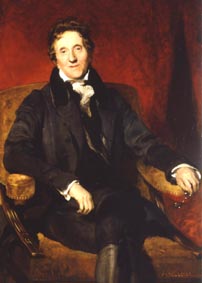
Sir John Soane RA FSA FRS 1753-1837
This is a journey into Space and Time: The Picture Room at Sir John Soane’s Museum
Moving on through the museum you might then enter the small panelled Picture Room where, among other pieces, you will discover the work of William Hogarth 1697-1764. Four large richly painted Hogarth scenes greet those who enter this room. Vibrant colours abound and the paintings are as fresh as if it were just off the easel. Always one with an eye for theatre Hogarth works in scenes- four scenes that depict the progression of an election campaign, entitled Humours of an Election and painted in 1755.
The real secret of this room is revealed when the guard carefully opens the panels up to reveal eight more Hogarth’s- The Rake’s Progress- a piece of theatre that would have appealed to Mr Hogarth. These smaller paintings have as much impact as the four larger scenes but it is the curation of both series in combination that leaves an indelible mark on the soul of the viewer. Why hide the Rake behind the Election Series? The easy answer is to say that space in London was at much of a premium then as it is now. A collector inevitably runs out of wall space eventually and innovative hanging systems, storage and rehangs are a solution. Whilst this is clearly true in a house as crowded as Soane’s I believe it is not the whole truth. Was the Rake too much to take? Was he hidden to protect the modesty of Soane’s gentler visitors from scenes of debauchery and prostitution? Possibly so, but maybe more accurately the reason might be to intsensify the experience and tease the viewer, it’s a piece of theatre, like a wurlitzer emerging from an old music hall floor or a new plasma screen rising out of some hidden home entertainment system. I believe all of these possible reasons are valid but there is a possibility that is even more compelling.
Room-in-a-nation rumination: ‘A Nation in A Room’
On two occaisions I’ve been lucky enough to stand and think about these works here on my own in the Picture Room and then deliver lectures standing before them. Ideas crystalize under such conditions. Evidently Sir John Soane was fond of working models of the architectural kind and my theory is that he curated this space for his Hogarth collection with one particular aim; that it be experienced as a three dimensional model of society, one that details the relationship between a corrupt society and the consequent corruption of the individual citizen within it’s structures. Soane is attempting to bring a real experience of these socially real paintings to his audience. He wants to create a 360 degree view of a society just like some of the great television series of recent times such as The Sopranos,The Wire and Madmen, have attempted to do.
Much like a building that lets in the rot over time and then when the walls are stripped back the real decay is visible, the Picture Room is therefore a dissection of the moral state of a nation. Hogarth’s Humours of An Election Series confronts us with the veneer of the structures that exist within society- the political system, democracy in action- but once the skin of the panels is peeled away we see the beating heart of the Rake and glimpse the damage hidden behind the surface corruption. A failure to address societal problems at surface level, corrupt institutions, greed and moral degeneracy in combination with parental neglect, human weakness, social neglect and mental illness are all the unaddressed factors that lead the Rake to the fate where he is desperately raking and clawing at his own skin on the floor of a mental institution.
If the rest of Soane’s museum is a paean to absence and loss and the passing of civilisations then here in this small room is the greatest national meditation on life and the lived experience of the modern English peoples as they grapple with the effects of industrialization and the foundations of Empire. Whilst filling a museum with fragments of the great ancient civilisations, gathered with such care, wonder and reverence Soane must have paused often to think how such societies could come to fail. The Picture Room may well have been conceived as a warning to a civilisation undergoing rapid industrial and global expansion. Everything from the past that can be classified is classified, apart from the thoughts of future generations that he wants to visit his museum. This is his legacy to us.
Let us examine our first patient then- Hogarth’s Humours of an Election Series. As Hogarth gives these four works such a corporeal title then let us view this body of work as a living body that contains Hippocrates’s four humours: blood, phlegm black bile and yellow bile. Hippocrates believed these four humours directly influenced the health of the body and its emotions Let us examine the health of this modern body before us then, this nation state, section by section.
Blood: ‘An Election Entertainment’
In Hippocrates’s theory of the four humours blood is associated with the liver and a sanguine nature, enthusiasm, activity and sociability. As you scan the paintings in the Picture Room you see the first of the four of Hogarth’s political scenes illustrating the election of a member of parliament in Oxfordshire in 1754, completed in 1755.
‘An election Entertainment’ is a cod version of Da Vinci’s last supper- but one exquisitely painted. It is a realistic evocation of a lively social scene with the food painted as well as any Dutch master- two European references already then for a man known for his xenophobia, and yet Hogarth’s fascination with Renaissance structure and symbolism and Dutch realism and sensuality is strikingly evident.
This is a last supper indeed for it depicts the bacchanalian dinner that amounts to a chance for the Whig candidates in the political classes to bribe the invited electorate ahead of the forthcoming election that unites the whole Humours series. See the Mayor gorging himself on oysters and the Judas politician’s kiss for the pregnant woman- a betrayal of two generations in one then.
Hogarth depicts the political class in the business of maintaining power, influence and privilege whilst simultaneously abdicating the responsibilities of office in exchange for short term financial gain to the gathered community leaders. An age old story to a modern audience this then, but told here by an artist with the memories of the boy he had once been, wide-eyed and watchful in the debtor’s prison, witnessing the adults around him dragged down by the chains of poverty.
It’s only then that you notice the blood as a brick flung from outside strikes an Election Agent square on the head. In fact two heads have been cracked in thie painting. Here is the reality of cause, effect and the pain and bloodshed it brings. This is not a game. It’s not an Entertainment. Real people get hurt. Your eye is drawn to the mob of anti-Semitic Tories outside, carrying an effigy of a Jew- hanging like a corpse- and declaiming the rights of immigrants. An age old story indeed. But who told it first? Hogarth did.
The message he brings through could so easily be mere moralizing in another artist’s hands, losing the audience along the way. But Hogarth brings us a painting so full of life that it makes you chuckle out loud- look at the Baronet -the very recognisable Irishman Sir John Parnell, friend of Pope and Swift and great-great-grandfather of the Irish nationalist leader Charles Stewart Parnell- he is making his handkerchief into a puppet. It’s hard to imagine a more symbolic distillation of the essence of this scene; politicians entertaining audiences with trickery and sleight of hand, turning them into puppets for their own advancement.
The satire in this bittersweet feast still tastes as bitter to us today. Showmanship trumps reform as we buy into this pantomimic black comedy, Hogarth is saying. We are dazzled like children at the feet of political conjurers The spectacle of all of this theatre is more interesting to behold than those figures in dark suits behind the scenes who change the scenery and rewrite the play before we’ve even noticed that the first act is over.
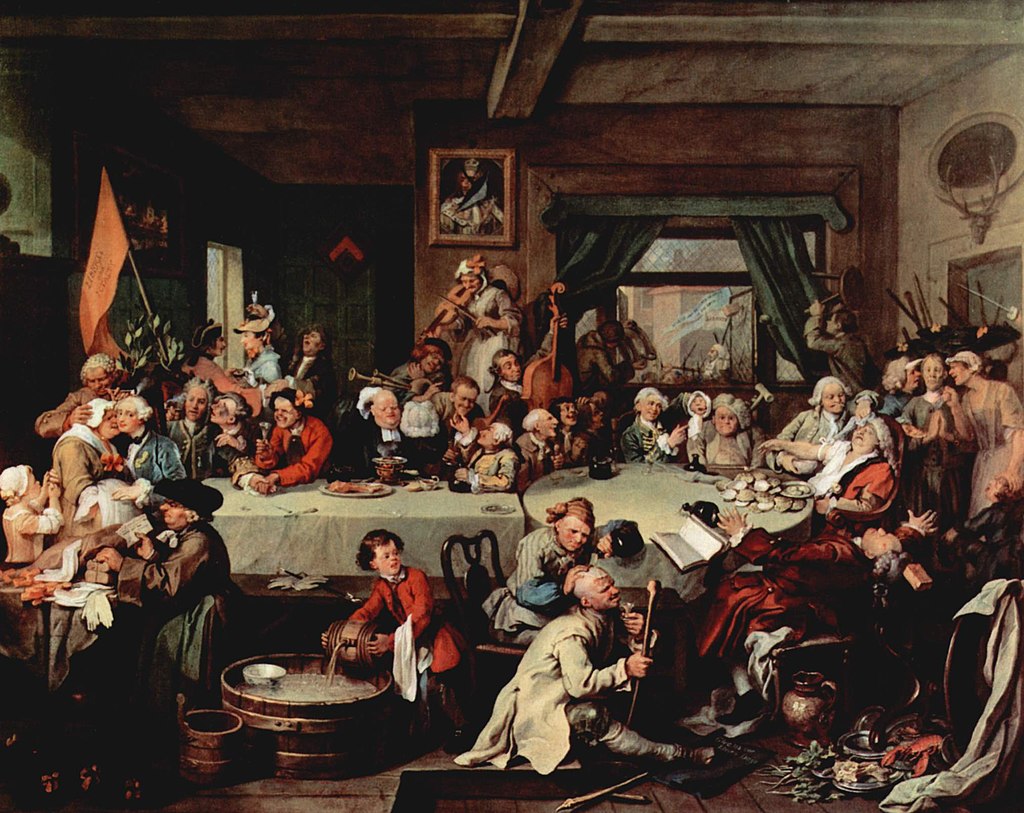
‘An Election Entertainment’ by William Hogarth 1755 from Four humours of An Election
Phlegm: ‘Canvassing for Votes’
In the four humours phlegm is associated with apathy and Hogarth fills his second Humour with images of apathy. Old men with the past stuck in their throats, coughing over their pipes in the form of a couple of old soldiers. They are recreating the famous naval battle of Portobello from pieces of chewed old broken pipes. As they relive their fragmented past glories the present moment swirls around them. One looks to have lost an eye in the service of his country in a graphic depiction of the reality of the decisions that are made behind the scenes by the influential and the powerful.
There is more spittle flying in this scene as desperate election agents, Tory and Whig, attempt to bribe an innkeeper to vote for them, physically rooting him to the spot in the middle of the street. Another anti-Semitic rabble jostles in the background but it’s a Jewish peddler who is employed by another agent to offer bribes to the wives of voters.
More imaginary spittle as a wooden figurehead, now impotent in its new life as a pub decoration, slathers and slobbers over the French fleur-de-lis and a woman watched by a transfixed drooling soldier, looks down, lost in the moment with her paltry bribes. It is hard to imagine a more perfect depiction of the paralysis and introspection that effects a nation as it embarks on an election or a referendum than Hogarth’s ‘Canvassing for Votes’ Such apathy all too easily translates into empty poll booths.

‘Canvassing for Votes’ by William Hogarth 1755 from Four humours of An Election
Black Bile: ‘The Polling’
The word Melancholy derives from the greek word for ‘black bile’. In the third Humour Hogarth presents us with a sorry scene from the poll booths as the nation casts its vote and democracy is cajoled, dragged and carried to its civic duties. A Whig voter and old soldier, absent of hand and leg is being challenged because he is placing his hook, rather than his hand, on the Bible. Tories are bringing a mentally disabled man to vote and a dying man is being carried in behind him. This melancholy scene is a depiction of democracy in action. The wheels have quite literally come off- the symbol of Britannia, a woman in a carriage with a broken axle, is in distress while her coachmen are gambling, ignoring her cries.
In a beautiful clever nod to the four paintings in the series and an in-joke on the title of this one, four poles are carried by four men we imagine at the bottom left of the painting. Perhaps they are also leading towards the inevitable fracas of the final painting.
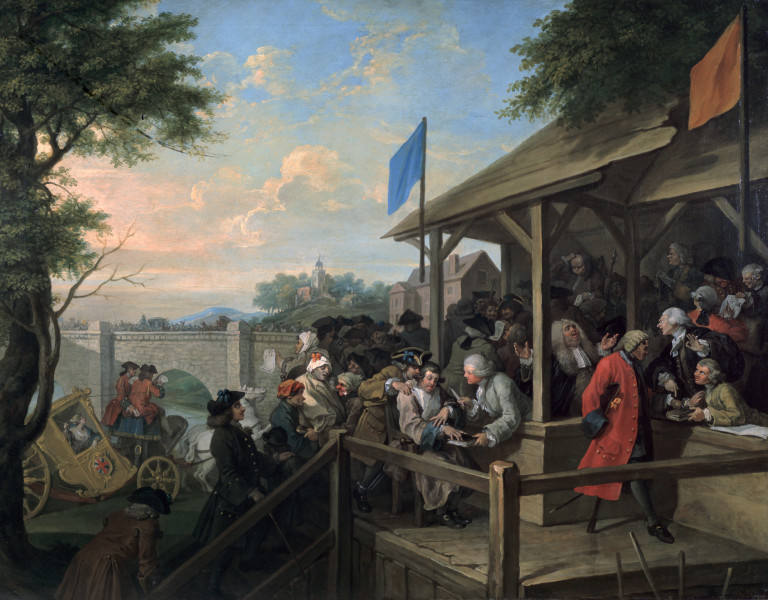
‘The Polling’ by William Hogarth 1755 from Four humours of An Election
Yellow Bile: ‘Chairing the Member’
According to Hippocrates’ theories of the Humours, excess of yellow bile produces aggression and anger and imbalances the four humours. In the final scene we are in full riot mode. One of the victorious Tory candidates is being carried through the streets on a chair in a traditional ceremony. He is about to tumble down because one of his carriers has just been accidentally hit on the head by a flail carried by a Tory-supporting rural labourer who is attempting to fight off a Whig supporter- the old sailor with the bear. Town v Country, the modern clash between industrial and rural life. A group of frightened pigs run across the scene in a reference to the story of the Gadarene Swine in which Jesus excorcised demons out of a man and into a herd of pigs. A monkey rides the bear in an imitation of the new MP being carried aloft on the shoulders of his hoodlums. Young chimney sweeps- the real victims of the industrial age- maintain the moral high ground by urinating on the monkey and placing spectacles on a stone skull making death gaze in clear-sighted alarm upon the chaotic cavalcade. In the meantime the Whig politicians are feasting and plotting and a sinister hand in a window top left drafts a new policy- the scenery changed with a sleight of an unseen hand.
There are two correlating moments of genuis that particularly stand out in this painting. The sundial fixed to the wall reads: ‘Pulvis et umbra sumus’ ‘We are but dust and shadows’ and the far building has a shadow on it- the shadowy figure of the next politician already coming around the corner onto the scene.

‘Chairing the Member’ by William Hogarth 1755 from Four humours of An Election
Diagnosis:
The Election Humours reveal a society rotten with the diseases of corruption, conceit, vanity, apathy, and violence. This circus will continue, shadowy figures will control the fate of the populace, self-interest and corruption reign and we become dust.
Enter the Rake!

Painting 1’The Heir’ from the Rake’s Progress 1732-4

Painting 8 ‘The Madhouse’ fromThe Rake’s Progress 1732-4
At this moment the guard in the Picture Room will reveal Hogarth’s Rake’s Progress series and we can meet Tom Rakewell ‘the Rake’ for the first time.
An analysis of the symbols and hidden meaning of this depiction of Tom Rakewell’s fall from grace as he inherits and blows the wealth he ‘rakes in’ from his inheritance left by his miserly father must wait for another time.The point is that here is a depiction of the progress of a corruptable soul -look at the innocence on Tom’s face when we meet him as the panel is pulled back to reveal him being fitted for a new suit in the first painting in ‘The Heir’. A new suit for a new life indeed but alreadyhe is trapped in the grip of those that will feed off him. Contrast this with the torment and terror of the mentally ill man in the final scene in bedlam, ‘The Madhouse’. Every time we meet tom in the series he is surrounded and clamped in by the hands of others, shackled to desire, apathy, lust, greed, rage and fear.
Wrapped around Tom’s story, sealing it in like a tomb, is the story of the Election and the corrupt political class that seek to trap the individual and prevent free will. This visceral gutting of society by England’s greatest artist William Hogarth has been brilliantly reconstructed for us by the expert curator John Soane.
How to build a Rake well
It is hard though not to see Soane’s purchase of the Rake’s Progress at Christie’s in 1802 as somehow prophetic when we examine his personal life. Soane’s own father, a bricklayer, had died when he was just 14 and Soane had risen from humble beginnings to become one of the leading architects of his day, designing many neoclassical buildings including the Bank Of England. Soane and his beloved wife Eliza hoped that one of their two sons, John b.1786 and George b.1789 would go on to become architects, but it was not to be.
Although Soane acquired the Rake’s progress series when his sons were very young the boys would have grown up knowing the narrative of the paintings very well. Perhaps he had a glimpse of the privileged lives they would live in contrast to his own unsettled youth and thought would be morally educational acquisition for their impressionable young minds. His sons were a disappointment to him early on, both John and George were lazy and George had an uncontrollable temper. Relationships were always strained and became fractured.
After his marriage George wrote to his mother ‘I have married Agnes to spite you and father’ and then tried to extort money from Soane in 1814 claiming he would otherwise be forced to become an actor poor soul. George was sent to prison for debt and fraud until Soane’s wife Eliza repaid her son’s debts to secure his release. George went on to have relationships with his wife and her sister and was an abusive husband. Soane set up an allowance for his son John’s wife when she became a widow after his early death.
Days after his father’s death and despite receiving an annuity, George challenged Soane’s will on grounds of insanity. Soane wrote that he had left George so little because ‘his general misconduct and constant opposition to my wishes evinced in the general tenor of his life’. He lost his legal challenge and the case was thrown out. Soane left another annuity to his daughter in law ‘not to be subject to the debts or control of her said husband’.
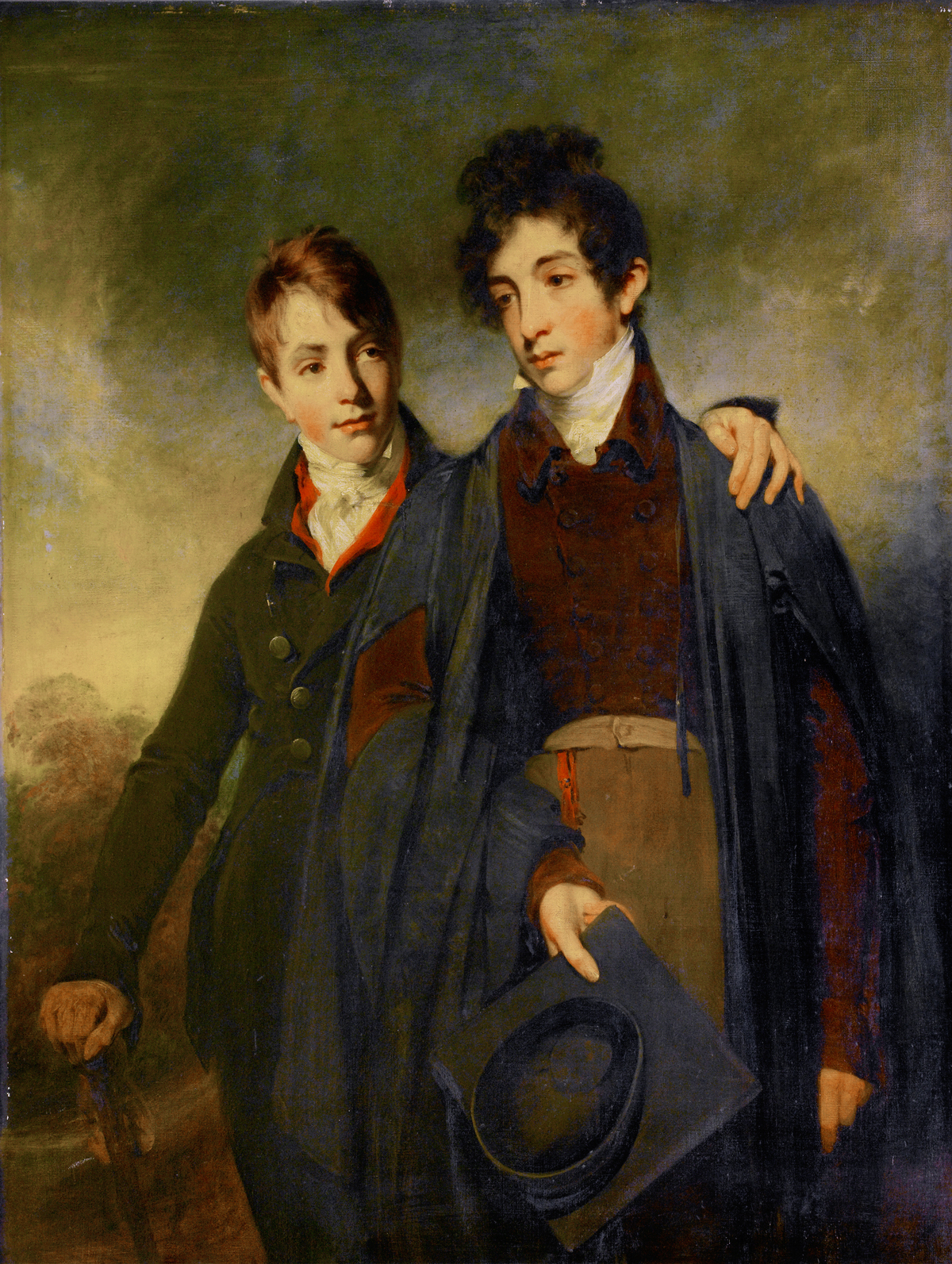
George and John Soane by William Owen 1805
Prognosis
Such a personal experience of the corruption of the individual, perhaps through his own accrued wealth and social status must have caused immense distress to Soane and certainly made his wife Eliza unwell.
These theories are mere suppositions on my behalf but standing before these paintings in an architecturally designed space it is possible to draw certain conclusions. Through clever curation on Soane’s part a resounding message is being relayed to us down the ages by a Georgian modernist painter and amplified by a neoclassical time-traveller architect within the space of the Picture Room: We are only as good as the institutions we elect to govern us. Our own vanity, apathy, greed, prejudice and self-interest are the buttons that need to be pushed in combination to turn a functioning democratic society into one mired in corruption, violence, persecution and bedlam. The individual and the society exist in symbiosis. An unwitting collaboration between Mr Hogarth and Sir John Soane has resulted in an innovative Georgian art installation that reveals how the bile of power play that washes through our political classes filters through to the individual. The rot that sets in ultimately destroys the youngest and most vulnerable members of society- a story as true for Georgian society as it is for ours today.
A visit to Soane’s Picture Room reminds us that the distance between the worst of the political elites in society and those who who are scrutinised and demonized at society’s lowest levels is about as thin as the veneer on a panel in a room in a house in Lincoln’s Inn Fields.
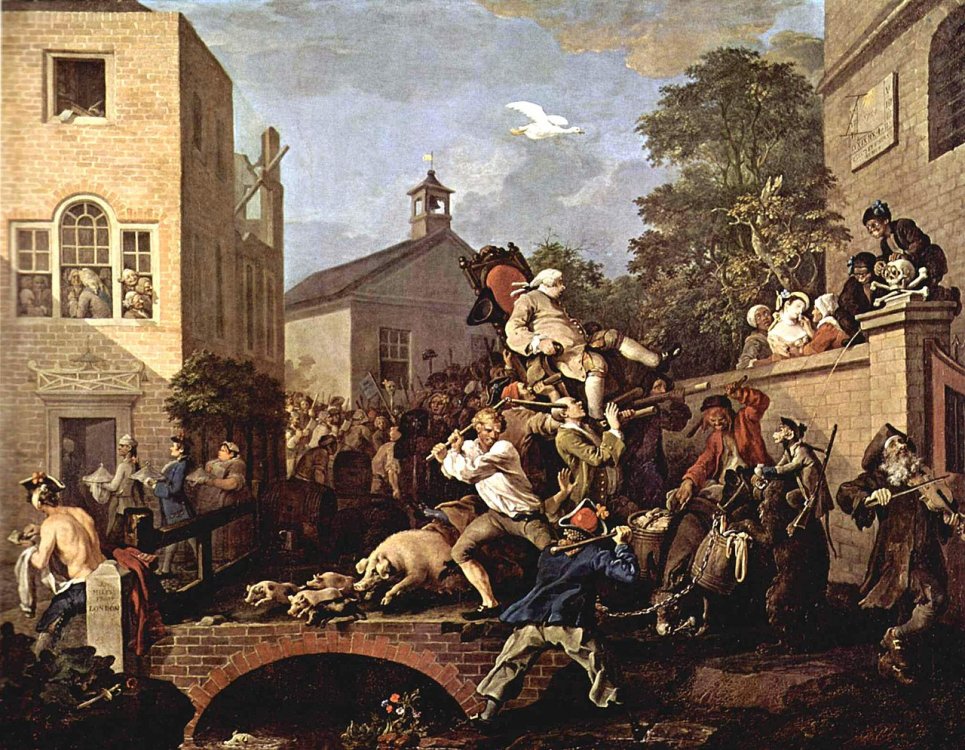
Kosmo Vinyl
9th October 2019 1:09 pm
Thank you for sharing your observations and thoughts on what is surely one of the jewels in the crown of London. I can’t help but wonder if Sir John Soane tempted fate (is such a thing really possible ?) when he housed Hogarth’s “Rake’s Progress” ? It certainly could not have been easy for him to look at when his son George behaved so atrociously.
Ed Gray
9th October 2019 1:36 pm
Thanks Kosmo it does seem an amazing coincidence. The Soane sons may indeed have delighted in the Rake’s rebelious nature and his rejection of order in favour of excess and chaos.
I’ve now new thoughts about this thanks to input from my friend the artist ‘Soho George’ Skeggs. George reckons that the Rake’s positioning behind the panels maybe a kind of metaphorical ‘skeleton in the closet’ for Soane in reference to his relationships with his surviving sons. I love that idea. Thinking on this the hidden Rake seems almost to be a badge of shame, screened off and revealed in a controlled way, perhaps when public atonement was needed for Soane’s own failure to exert control over his emotional environment with the same obsessive attention to detail that he brought to controlling the physical environment in his home and more demonstrably through his impressive architectural practice.
All guesswork of course but its clear to me at least that this is a choreographed performance as much as an innovative hanging system.